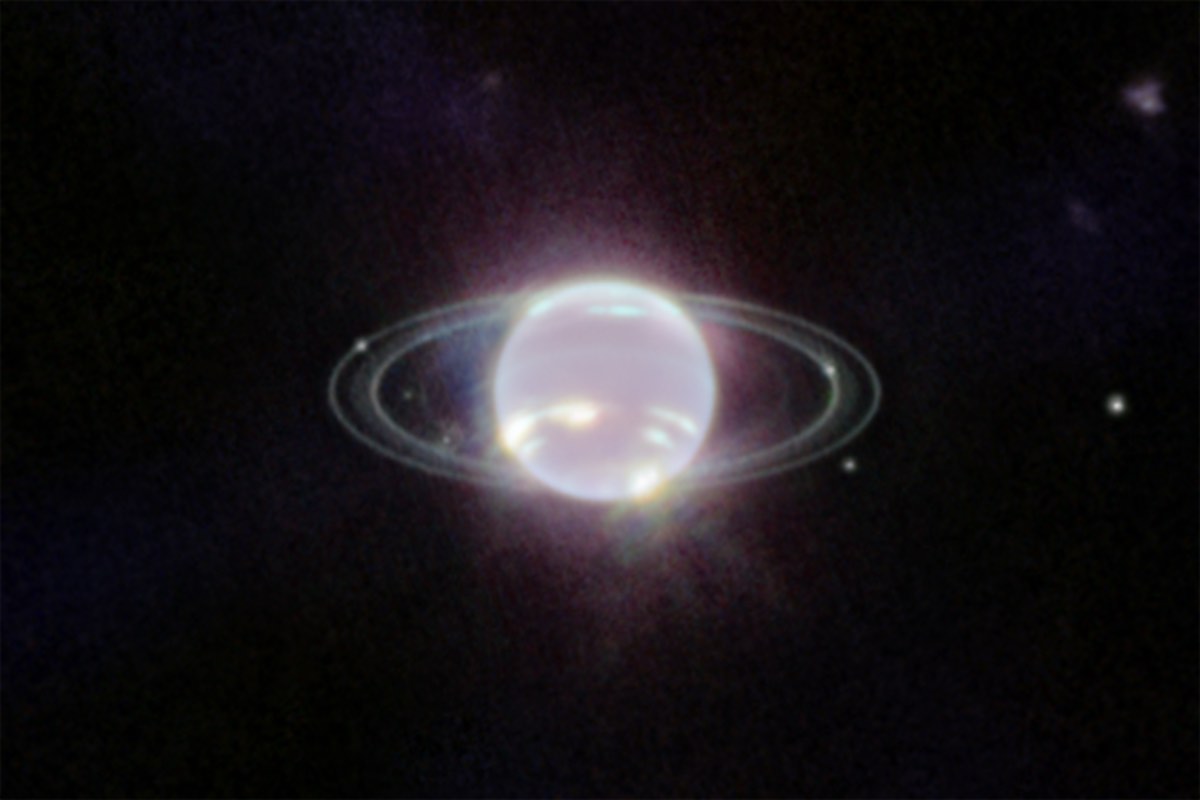
Fresh images from the James Webb Space Telescope show the faraway planet Neptune hung amid a tapestry of even more distant galaxies, the latest view from a now-regular flow of observations from astronomers’ new eye on the universe. Scientists released Webb’s first views of Neptune and Mars this week.
The infrared reveal the hard-to-see rings of Neptune, the best views of the giant planet’s rings since NASA’s Voyager 2 spacecraft zipped by Neptune in 1989. And Webb provided the first-ever look at the faint dusty rings in infrared light.
Heidi Hammel, an astronomer with expertise in observing the solar system’s outer planets with telescopes, tweeted her glee at the new pictures from Webb.
“Not gonna lie. I ugy-cried when I saw THE FIRST JWST NEPTUNE IMAGES! ‘O M G – LOOK AT THE RINGS’,” Hammel tweeted. “I was yelling, making my kids, my mom, even my cats look. More than 20 years in the making, and JWST delivered.”
Webb launched last December and began regular science observations in July. The observatory is the largest space telescope ever launched, with a primary mirror stretching more than 21 feet (6.5 meters) in diameter. The mission is a partnership between NASA, the European Space Agency, and the Canadian Space Agency.
The latest results from the $10 billion mission are part of the first year of Webb’s science campaign, when scientists and institutions who helped build the telescope receive guaranteed observing time. The wider science community will get time on Webb by proposing ideas for observations.
Neptune orbits the sun 30 times farther than the Earth. At an average distance from Earth of 2.8 billion miles (4.5 billion kilometers), Neptune is not visible to the naked eye, despite its size four times bigger than our home planet.
Webb’s view of Neptune looks different than most pictures of the distant planet, which has a blue hue in visible light images captured by ground-based observatories or the Hubble Space Telescope. The blue is caused by small amounts of methane gas in Neptune’s atmosphere.

Methane is a strong absorber of infrared light, so the blue signature does not appear in Webb’s observations. But Webb does reveal high altitude clouds in Neptune’s atmosphere. And Webb’s unrivaled resolution and sensitivity shows Neptune’s faintest dust rings that aren’t seen by Hubble.
The power of the James Webb Space Telescope is also apparent in a wider view of Neptune captured by the observatory’s Near Infrared Camera, or NIRCam, instrument. This image shows galaxies and stars dotting the cosmic landscape beyond.
Neptune circles the sun once every 164 years, with seasons lasting decades. The planet’s current tilt hides Neptune’s north pole from the view of Webb and other telescopes on or near Earth. The north pole is at the top of the planet in Webb’s view, but the new observations show “hint at an intriguing brightness in that area,” NASA said in a press release accompanying the images.
“A previously-known vortex at the southern pole is evident in Webb’s view, but for the first time Webb has revealed a continuous band of high-latitude clouds surrounding it,” NASA said.
“More subtly, a thin line of brightness circling the planet’s equator could be a visual signature of global atmospheric circulation that powers Neptune’s winds and storms,” NASA said. “The atmosphere descends and warms at the equator, and thus glows at infrared wavelengths more than the surrounding, cooler gases.”
Webb’s near-infrared camera also spotted seven of Neptune’s 14 known moons. Triton, Neptune’s largest moon, is brightest among the group, appearing like a star with diffraction spikes, or image artifacts common in reflecting telescopes and cameras.

Triton is highly reflective with a blanket of frozen nitrogen. Sunlight bounded off Triton’s icy surface makes the moon appear brighter than Neptune in Webb’s infrared imagery. Scientists believe Triton could have formed in the Kuiper Belt, a ring of icy worlds in the outer solar system beyond Neptune, a population that includes Pluto. Neptune’s gravity could have captured Triton into its orbit billion of years ago.
The observations of Neptune were released Wednesday, two days after officials published Webb’s first images of Mars.
The Red Planet is one of the brightest objects in the sky, and one of the brightest targets observable with Webb. With some special precautions, scientists can use Webb to image the planet and measure the composition of its atmosphere, providing a global perspective alongside observations collected by rovers and orbiters operating at Mars.
Webb can help study dust storms, Martian weather patterns, and seasonal changes, according to NASA. The telescope takes very short exposures when looking at Mars to avoid blinding of its infrared detectors.
The images below show views of Mars captured at different wavelengths by Webb’s near-infrared camera. At top right is an image from NIRCam’s shorter wavelength detectors, showing surface details similar to those apparent in visible-light images, NASA says.

The image at lower right was collected at longer wavelengths in the infrared range of the spectrum, showing thermal emission, or heat energy radiated back into space by Mars. The brightness of this image is related to the temperature of the Martian surface and atmosphere, with the brightest region where the sun is nearly directly overhead on the Red Planet, also called the subsolar point. Dimmer regions near the poles and the southern hemisphere were receiving less sunlight when Webb was pointing at Mars.
The darker part of this longer-wavelength image near Hellas Basin, a large impact site in the southern hemisphere of Mars, illustrates the absorption of infrared light by carbon dioxide in the Martian atmosphere. Hellas Basin is at a lower altitude than surrounding regions, meaning the air is thicker and there are more carbon dioxide molecules to absorb light, resulting in a darker region in Webb’s image.
Email the author.
Follow Stephen Clark on Twitter: @StephenClark1.
from Spaceflight Now https://ift.tt/NzPbRT8
via World Space Info







0 comments:
Post a Comment